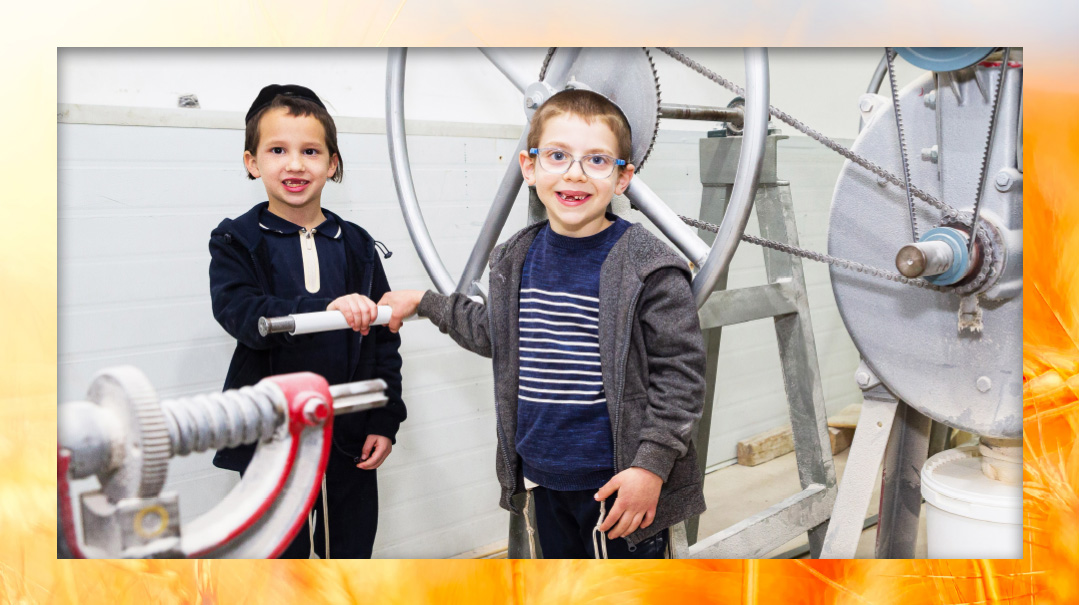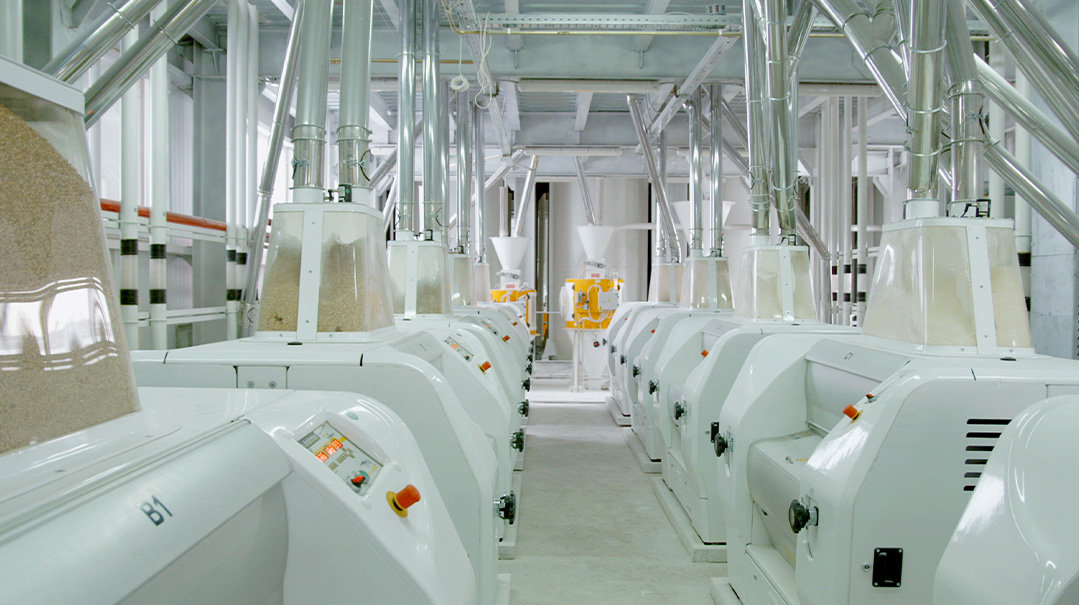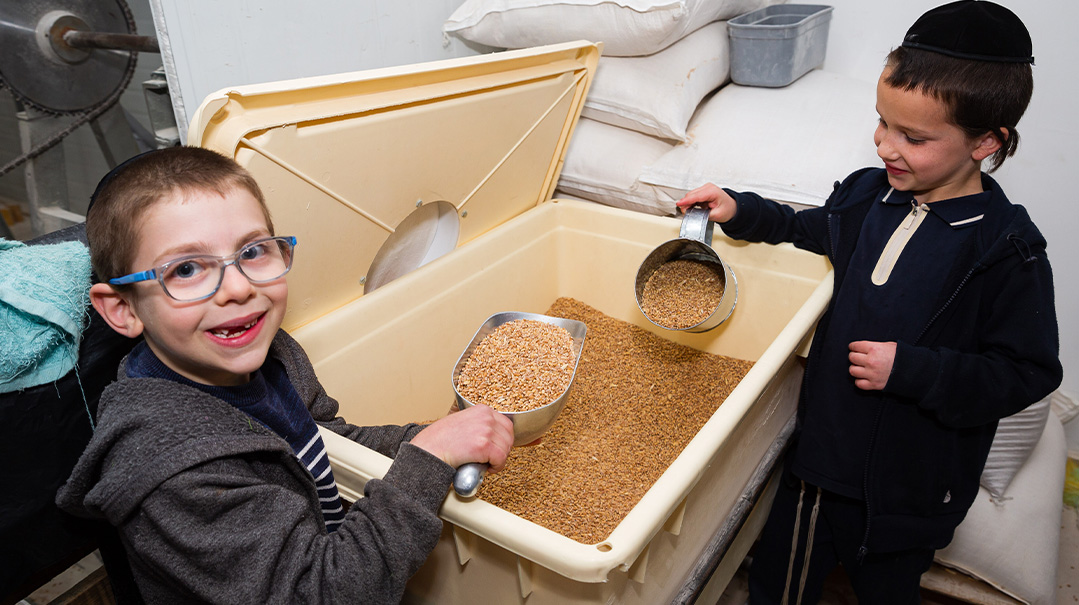The Step Before
| April 11, 2022What happens before the matzah bakery, before the water and flour and 18 minutes

Photos: Elchanan Kotler
In kindergarten, you learned that flour comes from wheat. And that wheat grows in great big wheat fields — long, straw-colored stalks waving gently in the breeze. But most of us have never given much thought to the process of those tall stalks becoming our bread, or matzah, as the case may be.
Wheat grows in the field just like any other crop. When it’s ready, it needs to be harvested. In other words, it needs to be cut so that it is no longer connected to the ground and can be carried away. In the past, a tool called a sickle — a large, rounded blade connected to a handle — was used to harvest the wheat. As you can imagine, that was very time-consuming, labor-intensive work. In the 1830s, the very first machines were being invented to help out with this chore. Get ready for a grand entrance, World: Welcome the Combine!
The combine, an amazing harvesting machine, changed the world of farming.
Not only does the combine actually harvest the wheat, it also completes the next step, all on its own! So, what’s the next step? I’m glad you asked!
Have you ever studied a stalk of wheat up close? Growing out of the straight, middle stem are many smaller stems, each one connected to a closed, individual wrapper known as the chaff. When you peel away the dry chaff, inside each almond-shaped wrapper is one tiny kernel of wheat. The kernels look a little bit like a grain of rice, but shorter, plumper, and darker.
Can you imagine how hard it was to harvest the wheat, and then remove each grain from the chaff? The terms “threshing” and “winnowing,” which you might have come across in the context of the lamed tes melachos, are ways that people used to do this. They’d walk on the stalks of wheat to loosen the kernels, and throw the stalks into the air to separate them. There were other ways to achieve this, but none of them were anywhere near as efficient as the combine. Not only does this machine harvest the wheat, it also does the separating! A massive chute coming out of the side of the combine delivers a steady stream of golden-brown wheat kernels into a waiting truck.
Great! Thanks to the combine, we now have truckloads of wheat kernels, ready to go. Now what?
Now we need to make flour. The way to do that? Yup — grinding, or milling, the kernels. Each tiny little kernel is hard and solid. But when you crush it, you get a fine powder — flour. You can take a small handful of wheat kernels and bash them with a hammer to see for yourself.
But of course, to be efficient, hammering a few kernels at a time isn’t going to cut it.
Enter the mill.

What, exactly, is a mill?
A mill is a building in which grains are crushed to make flour. It can also be used to describe a small device, such as a countertop or handheld mill, which grinds things like coffee beans or pepper into a fine powder. Yes, that’s all a mill is — and milling is the process.
We visited a real mill in Eretz Yisrael to see just how it’s done, and we took along a photographer to share it all with you.
What happens at the mill?
The mill receives sacks (or truckloads, depending on the size of the mill) of wheat kernels, straight from the silo (a special tall building with regulated air pressure where the kernels are stored before they make their way to the mill). Once they reach the mill, the sacks are stacked, and sack by sack, they are ground into flour.
Let’s look at the process of grinding wheat kernels into flour!
Interestingly, the modern process for grinding wheat kernels into flour is more or less as it has always been. Though improvements have been made, the basic concept is exactly what it was in ancient times.
Although we have machines nowadays, many people prefer not to use machine-ground flour for matzah. Have you ever heard the following terms and wondered what they meant?
Rashi Matzos and Rasham Matzos. I used to think that this was matzah with chumras or minhagim from Rashi, and matzah with chumras or minhagim from someone called Rasham. (Rashbam, Rashba, Maharsha… doesn’t Rasham fit right in?)
Turns out they are actually just acronyms (a.k.a. rashei teivos).
RASHI = Rechayim shel yad (hand grinding)
RASHAM = Rechayim shel mechonah (machine grinding)
Yup, that’s all there is to it. Would you like your matzah Rashi or Rasham? Most hand-matzos (the round ones, as opposed to the square machine matzos) use rashi – rechayim shel yad – flour that was ground by hand. And that’s the flour that is made right here in this mill (and many others like it).

How do we actually grind the kernels by hand?
Well, it’s not only by hand; machines help here, too. The difference is that these machines are powered by hand, whereas the rasham matzos are ground by machines powered by electricity.
There are several ways to mill flour, some of which are not used for matzos (like roller mills and hammer mills) and some of which are used for matzos, such as the stone mill. This mill is made up of two large stones placed close together. One of them is stationary — it doesn’t move. The other moves in a circular motion. One of the rocks has a hole through the middle. The kernels are poured into the hole and settle into the space between the two stones. When the mill is activated, in our case by hand, the kernels get crushed between the stones. Ta-da — flour!

The Mill — Pieces and Parts
On top: the hooper, the big funnel-shaped part into which the kernels are poured.
The hooper feeds the kernels into the rock with the hole.
The stones: Nowadays, the stones are generally synthetic stones made of concrete, though if you want to get fancy (and expensive), you can find natural stone mills. There are grooves in the stones that help to crack the kernels.
The handle: a long handle is pushed around and around to turn a huge wheel connected to the stone, which makes the stone move in a circular motion.
The chute: coming from the stones is a chute where the powdered kernels pour into a large bucket.
Wow! Now we have flour!
You peer into the bucket excitedly, but… that doesn’t look like flour. It’s coarser than the flour you’re used to. And it’s not really white — it’s a mix of light brown and white and various shades in between. It certainly doesn’t look like the fine white flour you were expecting.
There’s a good reason for that. When the wheat kernel gets crushed, all the parts of the kernel are there: the germ (that’s the part with the most nutrients and is where a new stalk of wheat would sprout if we planted the kernel), the bran, and the endosperm. Regular white flour is made from just the endosperm, and has very little nutrients. Whole wheat flour includes the germ and the bran, making it healthier and darker. Also, you’re probably used to sifted flour. This flour hasn’t been sifted yet.
WONDERFUL WHEAT
There are several kinds of wheat. And each kind is typed by season.
For example, we have red wheat and white wheat.
If white wheat is planted in the spring, it will grow differently from white wheat planted in the winter. Therefore, we have red spring wheat and white winter wheat and so forth.
Wheat can also be classified as hard wheat (spring) and soft wheat (winter).
Different kinds of wheat are better for different things. Hard wheat is better for baking bread. (The flour you buy in the supermarket is a mix of soft wheat and hard wheat, so it’s actually not the best flour for challah.)
Because the wheat used in matzos in Eretz Yisrael is a mixture of two or three types of hard wheat, the dough is stronger and less likely to rip, so the matzos here can be made thinner. In the US, a mixture of hard and soft wheat is used, so the matzos are thicker and softer.
On to the next step!
Now the raw flour is lugged over by the bucketful to the large sifter. If you want one of those fancy guys for yourself, no problem. Just hand over $10,000 and you’re good to go! These chaps are not cheap, but they sure do the job. Sifting the flour removes the bran from the rest of the flour (the larger pieces of bran stay behind in the sifter). It also ensures that no sneaky whole kernels got in, which can happen if there is a crack in one of the mill’s stones, and is a halachic problem — i.e. chashash chometz! Overfeeding the mill can also lead to runaway kernels. Making sure the hooper feeds just the right amount of wheat at just the right pace is crucial, both for the quality of the flour and to avoid those stray kernels.
Now that the flour is sifted, it looks more like the powdery white stuff with which we’re all familiar. The flour is loaded into large sacks (each sack contains 25 kg, over 55 pounds of flour) and then shipped off to their next destination, the matzah bakery, where they will be baked into the matzos you’ll soon be enjoying.
Did you know
»The wheat for matzos is harvested as much as a year before Pesach!
»Matzah bakeries are hard at work at least three months before Pesach!
»The flour is always sifted again when it gets to the matzah bakery. This is to ensure that there are no lumps of flour in the dough. (Hello, gebrochts. This is the source of that minhag! If a lump of flour were to find its way into your chicken soup on Pesach, it potentially could become chometz, depending on varying factors.
»In Eretz Yisrael, all the wheat grown is high-quality hard wheat, since there is no “winter” climate in Israel. It doesn’t get cold enough! Wheat from Eretz Yisrael is one of the best hard wheats in the world because of the climate.
»Once the wheat is halachically done growing, rain can make it chometz, even while it’s still in the fields. If the wheat gets rained on before it can be harvested, you have to find new wheat — either wheat from an area where it didn’t rain, or wheat from a younger field, which is not fully developed yet, and didn’t halachically become chometz.
Have a chag kosher v’samei’ach and enjoy your matzah!
(Originally featured in Mishpacha Jr., Issue 907)
Oops! We could not locate your form.






